How to Choose a Longboard & Longboard Deck Shapes
There’s a lot more to longboards than meets the eye - everything from the shape of the deck to the wheel bearings have an effect on your ride. Longboards come with different shapes, construction, and have different features - they’re designed for various riding styles and abilities. So we’ve created this guide to help you choose the right longboard and get you on the streets as fast as possible! Along the way, we’ll also break down the different shapes and styles of longboards.
To choose the right longboard setup, you are going to want to consider:
Longboard Riding Styles
Within longboarding there are different styles of riding, with different style of longboards to match. Whether you want to cruise campus on the way to class, bomb the gnarliest hill you can find, or session a drainage ditch or park, different boards can make all of these things possible. The first thing to take into consideration when picking a style is where you live and ride. If you reside somewhere flat, you probably won’t be bombing too many hills, and if you live in the mountains, you’ll most likely be hitting hills, flats, and everything in between. Keep this in mind, as well as what you find the most fun.
Cruising & Carving Longboarding
Cruising and carving longboarding are all about carving down gradually sloped streets, ripping through the quad on your way to class, and long distance pushes on flat or slightly sloped ground. If you’re just getting into longboarding, this is most likely the type of riding you’ve either already done on your friend’s board or what you’ll start doing on yours.
Shop Cruising/Carving Boards
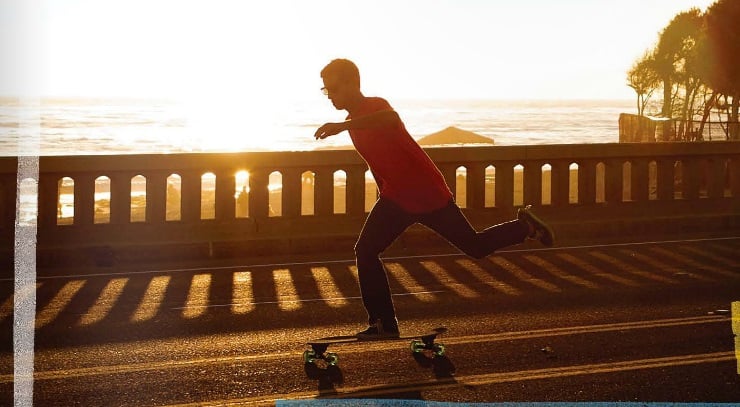
Downhill Longboarding
Downhill longboarding is all about bombing hills as fast as you can while maintaining control. You are usually in a crouching or tucked position on your board for reduced wind-resistance and increased stability. Just like in freeriding, it’s not uncommon to break those wheels out in a slide to control your speed, so true downhill isn’t the best style of riding for brand new riders.
Shop Downhill Boards
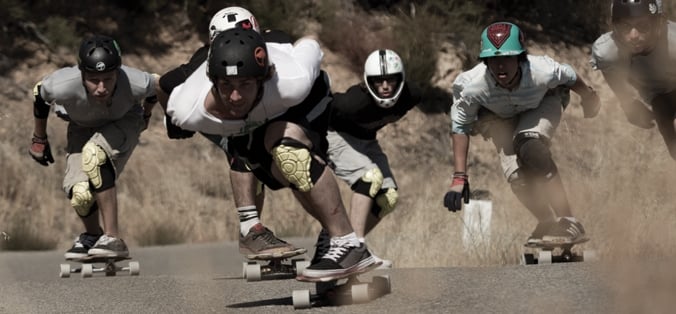
Freeride Longboarding
Freeride longboarding means that you are riding hills with a fair amount of speed while styling it up with slides and curb hops, as well as sliding to control your speed on bigger descents. This style of riding requires quite skilled board control and comfort at high speeds, so it’s typically reserved for more expert riders.
Shop Freeride Boards
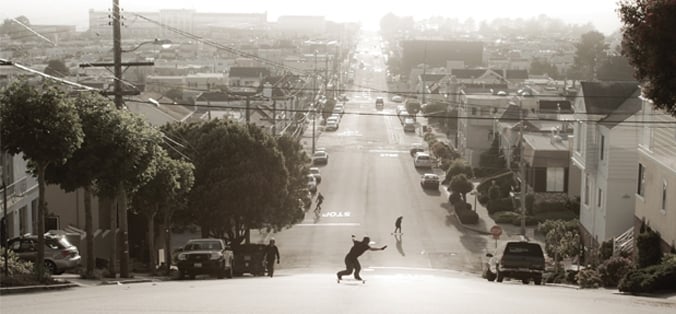
Freestyle Longboarding
It’s all about being creative, so you can pretty much ride whatever you want. Freestyle longboarding involves many technical skills such as sliding, board tricks, regular and goofy riding, and dancing, just to name a few. This type of riding is a good way for beginners to learn board control skills, but it’s also extremely enjoyable for advanced and expert riders.
Shop Freestyle Boards
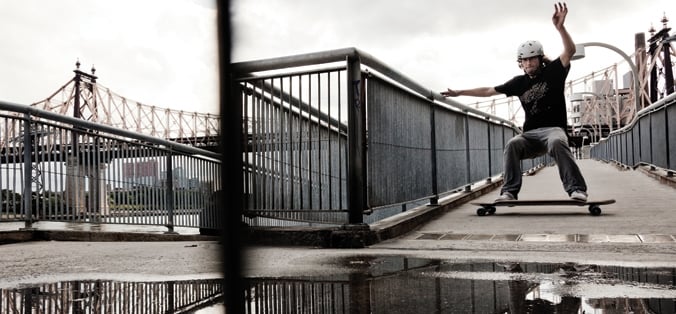
Longboard Deck Shapes
There are two general board shapes that all other designs fall into, directional and Twin or Symmetrical. Both board shapes are beginner and expert-friendly.
Directional Longboards
These boards are only meant to go in one direction: forward. The most popular directional board design is the famous Pin Tail, which doesn’t provide proper board feel or control while ridden switch. Carvers, cruisers and downhill boards are usually directional but there are some exceptions.
Twin (Symmetrical) Longboards
A symmetrical board looks and feels the same regardless of which way it is facing. If you plan on doing any 180° slides (common in freeriding and freestyle), a symmetrical board is the way to go.
Longboard Deck Styles
The deck style of a longboard play a key role in how stable the board is, how easy it is to foot-brake, and how easy it is to push on flat ground. As a general rule of thumb, the higher the board is off the ground, the higher the center of gravity will be, which translates to less stability and more fatigue while pushing and foot-braking. On the other hand, the lower the board is, the less leverage you have to toss quick carves and the more likely you are to bottom out on tight turns.
Top Mount Longboards
Top mount is the most traditional board shape in longboards, and it is also the least expensive. The deck is mounted above the trucks so the center of gravity is higher than on the other board styles. This makes the top mount slightly less stable but more nimble than dropped boards because of increased turn leverage. Top mount boards are the most versatile and can be used for cruising, carving, downhill, freeride and freestyle.
Drop Through Longboards
On a drop though longboard, the trucks are mounted “through” the board, which effectively lowers the deck height by the thickness of the board. This increases board stability and reduces fatigue while pushing/braking because you have to drop your foot less to contact the ground. These boards are great for long-distance riding (commuting), freeride and downhill riding styles.
Drop Deck Longboards
These decks are the weird-looking ones. Drop deck longboards are molded during construction in such a way that the area your feet ride on is below the trucks. This is a very effective method for lowering the center of gravity for increased stability and less fatigue while braking/pushing. The amount of drop is usually dictated in inches (ex. “0.625 inch dropped riding platform”). The drop deck style is typically found on downhill and some freeride boards. Drop deck boards top mount their trucks.
Double Drop Longboards
Lower than the lowest bar at limbo, double drop longboards feature both drop through trucks and the drop deck style to get your feet as close to the ground as possible ("double" drop). This is the most stable deck style, but it is also the least common due to its high degree of difficulty to construct, which can also make it the most expensive. This shape is generally only found on dedicated downhill boards.
Longboard (Shape) Features
All longboards come with certain shape features that provide specific riding characteristics and help dictate each board’s intended use. These features include kick tails, wheel cut-outs, and concave.
Kick Tail Longboards
Kick tails are what you see on both ends of regular skateboards. They allow you to lift one end of the board off the ground to perform tricks or hop curbs, as well as make quick turns. Longboards can have kick tails on just one end (on directional boards) or on both ends (on symmetrical boards). Kick tail longboard shapes are great for cruiser boards for last-second pedestrian dodges and curb hops, and a necessity on many freestyle boards.
Longboard Wheel Cut-Outs / Wheel Wells
Both wheel cut-outs and wheel wells are all about preventing wheel bite on your longboard, which is what happens when you corner too hard and your wheels contact your deck. This usually results in you getting thrown off your board (no bueno). Cut-outs generally allow you to turn the hardest because there is no way for the wheels to make board contact. Wheel wells allow you to turn sharp but will still allow for contact if your trucks are too loose, you don’t have large enough risers, or your wheels are too big.
Longboard Deck Concave
Grip tape keeps your feet on the board, but concave helps quite a bit, too. Concave essentially means that the edges or rails of the longboard deck are a little higher than the board’s center. When standing on the board, your feet will contour to this shape, increasing the contact area of your shoe, which in turn means more grip. The amount of concave usually depends on the designated riding style of the board: Downhill and freeride boards generally have deeper, more extreme concave than cruisers.
W-Concave Longboards
Just like regular concave, W-concave keeps your feet planted on the board. It’s actually like having two concave sections next to each other, which provides a lot of grip. This feature usually only comes on more expensive downhill and freeride boards.
Longboard Length & Wheelbase
Longboard length or more specifically, wheelbase length, plays a key role in turning and board stability. Longer boards (or those with longer wheelbases) will generally provide more stability at speed, but cannot turn as fast or as tight as boards with shorter wheelbases.
Longboard Size Chart
| Longboard Style | Rider Height | Longboard Size |
| Cruising | Up to 5'10" | 32-40" |
| Cruising | 5'10"+ | 40"+ |
| Downhill | Up to 5'10" | 35-42" |
| Downhill | 5'10"+ | 42"+ |
| Freeride & Freestyle | Up to 5'10" | 38-42" |
| Freeride & Freestyle | 5'10"+ | 38-42" |
Longboard Board Flex
Boards come in oodles of different flex ratings, which are dictated by many factors including board material, laminates, length, and amount of concave. The chart below provides information about what degree of flex is good for each style of riding.
| Flex | Characteristics | Ideal Application |
| Soft | Excellent shock absorption on rough roads. Very unstable at medium to high speeds. | Fun for mellow cruising and certain board tricks. |
| Medium | Maintains stability at speed. Provides a spring like feel that can add energy to pushes and carves. Provides good shock absorption over bumps. | Great for carving, moderate speed cruising and commuting. |
| Stiff | Most stable at moderate to high speeds. Least forgiving on bumpy or cracked pavement. | Best for bombing hills, going fast and freeriding. |
Longboard Construction
The most common and inexpensive board construction uses multiple thin sheets, called veneers, of maple or Baltic birch wood much like traditional skateboards. The veneers are glued, stacked on top of each other, and pressed into shape. The number of veneers varies between boards, but a general rule of thumb is that the more veneers used, the stiffer and heavier the board will be.
Bamboo laminates are also gaining popularity in the longboard world. A sheet of vertically laminated bamboo is wrapped or sandwiched in fiberglass or other composite materials. This typically produces a medium to lightweight board with a soft to medium flex and powerful spring-like characteristics.
The third and most expensive construction utilizes composite materials such as carbon fiber. A lightweight wood such as bamboo is usually combined with a piece of foam to create a very light core that is then wrapped in a composite material to add rigidity. These boards are known for their stiffness and light weight, making them desirable for serious downhill riders.
Longboard Trucks
The trucks attach the wheels to the deck and allow for turning and pivoting on the axle. Longboard trucks differ from those on normal skateboards in that they have a reversed or inverted kingpin. This provides a more side-to-side movement for better stability and control. Just like skate trucks, however, these can be adjusted to how easily they pivot. Tightening the nut on the kingpin compresses the bushings and creates a stiffer feel when turning. Looser trucks are better for turns, while tighter trucks are better for high speed stability. Changing the hardness or durometer of the bushings will also change how the trucks will pivot.
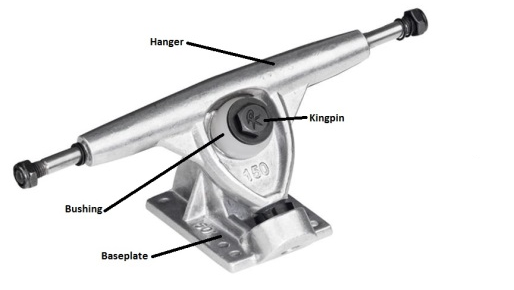
Baseplates
The baseplate is the part of the truck that is connected to the board via the four mounting hardware bolts.
HangersThe hanger, which pivots on the baseplate, is the part of the truck that acts as the axle, holding the wheels in place.
BushingsBushings are the rubber pads between the kingpin, baseplate and the hanger on a truck. There are two bushings per truck. Harder bushings are tougher to turn on but return more energy, giving a springier return to center or more resistance for pumping. Softer bushings absorb energy and impact, making turning easier. Tightening your trucks, via the kingpin nut, can also play a major factor in the type of ride you will have.
Top Mount, Drop Deck and Double Drop boards have their trucks mounted in the traditional style that is seen on normal skateboards. It’s important to note, however, that Drop Through decks require an extra step to install or remove the trucks. In order to remove or install the trucks, the hangers must be removed. To do this, simply loosen the kingpin nut all the way, remove the top bushing, and the hanger should come free. Now, once the normal mounting hardware is removed, the baseplate can be removed or inserted into the top of the board and the bushings, hanger and kingpin nut can be replaced.
Longboard Wheels
Wheels play a huge role in how your longboard preforms because they provide grip between you and the road, which affects speed and cornering ability. There are several different factors that dictate how the wheels will perform. These factors are shape, width and height, durometer and core style. Each factor is discussed below, followed by a chart to show which of the following features are best for each style of riding.
Longboard Wheel Shape
There are two shapes that wheels, or rather the lips of the wheels, can have: round and square.
Round Lip Longboard Wheels
Round lipped wheels are what you see on normal skateboards. The “edge” of the wheel is rounded, which provides less traction through turns. This means that they are easier to slide on than the square type, making them the clear choice for freeriders and freestylers. If you are new to longboarding or want to bomb hills and rail corners as fast as possible, look into square lipped wheels.
Square Longboard Wheels
Square lipped longboard wheels are the typical longboard wheel shape. Instead of the “edge” of the wheel being rounded, it’s, yes, square (at a 90° angle). This provides better contact with the road, which in turn provides much more traction and sliding resistance. Square wheels can still slide once broken in, making them excellent for downhill and cruising/carving.
Longboard Wheel Width and Height (Diameter)
The width of the wheel is the distance from the outer to inner edge of the wheel, or can sometimes be measured by the wheel’s contact patch. A wider wheel will generally offer more grip but will also be slower due to its increased contact with the ground. The height (also called diameter) of the wheel is the distance between where the wheel touches the ground to the top of urethane, in a straight line. It is usually listed in the name of the wheel and is measured in millimeters (ex. 75 mm / 78a). Larger wheels will offer a smoother ride because they can roll over cracks and obstacles with less effort, but they will also make for slower acceleration. Smaller wheels accelerate faster, but they increase the risk of you getting bucked off your board if you hit a large enough crack or piece of debris.
The height (also called diameter) of the wheel is the distance between where the wheel touches the ground to the top of urethane, in a straight line. It is usually listed in the name of the wheel and is measured in millimeters (ex. 75 mm / 78a). Larger wheels will offer a smoother ride because they can roll over cracks and obstacles with less effort, but they will also make for slower acceleration. Smaller wheels accelerate faster, but they increase the risk of you getting bucked off your board if you hit a large enough crack or piece of debris.Longboard Wheel Durometer or Hardness
Durometer tells you how hard the wheel is. It is listed in the name of the wheel, and is followed by a letter (usually either “a” or “b”) (ex. 75 mm / 78a). This letter explains what scale was used to measure the wheel. “a” wheels are made of a softer, more rubbery material, while “b” wheels are more of a hard plastic. The lower this number is, the softer and more rubbery the wheel will be. Soft wheels provide more traction and are better on rough pavement but are also slower due to more friction with the ground. Harder wheels, or those with higher durometer ratings, will have less friction, which makes for a rough ride on bumpy pavement, but they are also faster and easier to break out into a slide. Generally, beginner/intermediate riders should look for softer wheels in the 75a – 80a range for the best grip.
Longboard Wheel Cores
The core is the center of the wheel, and it’s what houses the bearings. There are three different types of cores: centerset, offset, and sideset.
Centerset Longboard Wheels
Centerset cores are found on most sliding and skateboard wheels. Its symmetrical design allows the rider to flip the wheels around once one side becomes worn, which effectively prolongs the lifespan of the wheel.Offest Longboard Wheels
Offset cores are located off-center, closer to the inside of the wheel. This offers a nice balance of grip and slide-ability.Sideset Longboard Wheels
Sideset wheels have their cores located very close to the inner lip of the wheel. This offers great slide-ability due to the minimal urethane on the inner lip, but they cannot be flipped once they become worn.Longboard Wheel Width Size Chart
| Riding Style | Wheel Height | Wheel Width | Durometer | Wheel Shape | Core Type |
| Cruising/Carving | Approx. 75 mm + | Approx. 55 mm | 75 - 80a | Square or Round | Offset |
| Downhill | Approx. 70 - 75 mm | Approx. 55 mm | 78a - 83a | Square | Offset |
| Freeride | Approx. 65 - 70 mm | Approx 45 mm | 80a - 86a | Round | Any Core |
| Freestyle | Approx. 55 - 65 mm | Approx 45 mm | 75a - 80a | Any Shape | Any Core |
Longboard Bearings
Simply put, bearings are what make your wheels spin. They are typically rated by a standard called ABEC, and the higher the ABEC rating, the faster your wheels will spin. Generally, ABEC 3 longboard bearings are good for cruising, ABEC 5 is good for freeride, and ABEC 5–7+ bearings provide maximum speed for downhill and racing.
It’s very important to perform regular maintenance on your bearings. This will help maintain them for optimum performance and durability. To do so, simply remove your bearings, clean, re-lube and re-install them. We recommend doing this after every 50 hours of riding (more or less) with a product such as Bones Speed Cream Bearing Lube. (Do this much sooner if you ride in the rain or through a puddle; water will cause bearings to prematurely rust.) NEVER USE WD-40! WD-40 and other household “lubricants” will actually dry your bearings out and reduce their performance and lifespan.
*Do not over-tighten your bearings during installation. This can severely damage them. If the bearings start to feel “crunchy” you’ve gone too far and need to loosen them.
Learn More With Our Other Skateboard Guides:
This is evo. We are a ski, snowboard, wake, skate, bike, surf, camp, and clothing online retailer with physical stores in Seattle, Portland, Denver, Salt Lake City, Whistler, and Snoqualmie Pass. Our goal is to provide you with great information to make both your purchase and upkeep easy.
evo also likes to travel to remote places across the globe in search of world-class powder turns, epic waves, or legendary mountain biking locations through evoTrip Adventure Travel Trips. Or, if you prefer to travel on your own, check out our ski & snowboard resort travel guides and mountain bike trail guides.
Still have questions? Please call our customer care team at 1.866.386.1590 during Customer Care Hours. They can help you find the right setup to fit your needs.